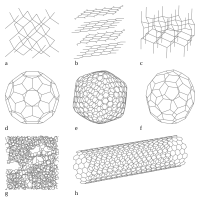
Photo from wikipedia
For the first time, σ-hole interactions within like⋯like carbon-containing complexes were investigated, in both the absence and presence of the external electric field (EEF). The effects of the directionality and… Click to show full abstract
For the first time, σ-hole interactions within like⋯like carbon-containing complexes were investigated, in both the absence and presence of the external electric field (EEF). The effects of the directionality and strength of the utilized EEF were thoroughly unveiled in the (F-C-F3)2, (F-C-H3)2, and (H-C-F3)2 complexes. In the absence of the EEF, favorable interaction energies, with negative values, are denoted for the (F-C-F3)2 and (H-C-F3)2 complexes, whereas the (F-C-H3)2 complex exhibits unfavorable interactions. Remarkably, the strength of the applied EEF exhibits a prominent role in turning the repulsive forces within the latter complex into attractive ones. The symmetrical nature of the considered like⋯like carbon-containing complexes eradicated the effect of directionality of the EEF. The quantum theory of atoms in molecules (QTAIM), and the noncovalent interaction (NCI) index, ensured the occurrence of the attractive forces, and also outlined the substantial contributions of the three coplanar atoms to the total strength of the studied complexes. Symmetry-adapted perturbation theory (SAPT) results show the dispersion-driven nature of the interactions.
Journal Title: Molecules
Year Published: 2022
Link to full text (if available)
Share on Social Media: Sign Up to like & get
recommendations!